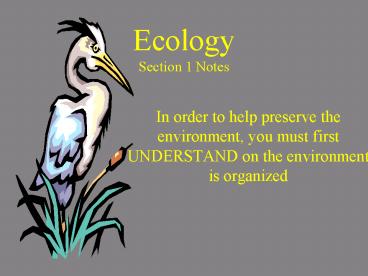Ecology Section 1 Notes PowerPoint PPT Presentation
1 / 14
Title: Ecology Section 1 Notes
1
EcologySection 1 Notes
- In order to help preserve the environment, you
must first UNDERSTAND on the environment is
organized
2
Applied Bio/Chemistry
- The student will investigate and understand
- dynamic equilibria within populations,
communities, - and ecosystems.
- Key concepts include
- interactions within and among populations
- nutrient cycling with energy flow through
ecosystems - the effects of natural events and human
activities on ecosystems and - analysis of the flora, fauna, and microorganisms
of foreign ecosystems
3
What is ecology?
- Ecology- the scientific study of interactions
between organisms and their environments,
focusing on energy transfer - It is a science of relationships.
4
What do you mean by environment?
- The environment is made up of two factors
- Biotic factors- all living organisms inhabiting
the Earth - Abiotic factors- nonliving parts of the
environment (i.e. temperature, soil, light,
moisture, air currents)
5
Biosphere
Ecosystem
Community
Population
Organism
6
- Organism- any unicellular or multicellular form
exhibiting all of the characteristics of life, an
individual. - The lowest level of organization
7
Population-a group of organisms of one species
living in the same place at the same time that
interbreed and compete with each other for
resources (ex. food, mates, shelter)
8
Community- several interacting populations that
inhabit a common environment and are
interdependent.
9
Ecosystem- populations in a community and the
abiotic factors with which they interact (ex.
marine, terrestrial)
10
- Biosphere- life supporting portions of Earth
composed of air, land, fresh water, and salt
water. - The highest level of organization
11
- The ecological niche of an organism depends not
only on where it lives but also on what it does.
By analogy, it may be said that the habitat is
the organism's address, and the niche is its
profession, biologically speaking. - Odum - Fundamentals of Ecology
12
- Habitat vs. Niche
Niche - the role a species plays in a community
(job) Habitat- the place in which an organism
lives out its life (address)
13
- Habitat vs. Niche
A niche is determined by the tolerance
limitations of an organism, or a limiting factor.
Limiting factor- any biotic or abiotic factor
that restricts the existence of organisms in a
specific environment.
14
Habitat vs. Niche
- Examples of limiting factors-
- Amount of water
- Amount of food
- Temperature

